At present, there are three types of protectors that we often see, namely, 8-letter rings, ATCs, and mechanical brakes. one. 8 word ring protector The 8 word loop protector is the first generation protector invented by the climber. It is characterized by its simple structure and easy operation. Its requirement for rope diameter is: 8mm or more and 13mm or less. The application range of the rope is relatively large, so the application scope of the 8 word loop is very wide, and it can be used for climbing, rock climbing, canyoning, rescue, and engineering. Different manufacturers of the 8 word ring in the appearance of a difference, as shown below, the most original is the round 8 word ring, because in use, the round shape is easy to twist the rope winding, so to make up for the lack of, some manufacturers The shape of the 8 word loop has been improved accordingly. For example: Huit and Huit Antibrulure produced by French PETZL company, Huit's square shape design can avoid the rope curling and difficult to operate; there is a small handle on the Huit Antibrulure, when the rope friction makes it hot, pinching the small handle can prevent Hand was burned. In addition, because the braking performance of the 8 word loop is not very sensitive, PETZL also developed and produced Pirana with multiple stopping positions, and its braking performance has been improved in the use for falling. The advantage of the 8-shaped ring type protector is that it is thick and hard-wearing, and it can also work well with harder ropes. The disadvantages are that it is slightly bulky and the brake locking performance is slightly inferior compared to other protectors. Suitable for fast protection operation and fast drop. two. ATC type protector When using ATC type protector, the ropes and ropes are very smooth, the ropes are not easily curled, and the operation method is simple. It can be used for single ropes or double ropes, and the braking performance is better than the 8 word loop protection. Climbers like it. Nowadays, a wide variety of ATC-type protection devices are available. The products of different manufacturers also have slightly different functions, so be sure to check the product manual carefully before use. At present, domestic common ATC type protectors are: ATC, ATC XP, ATC guide, REVERSO, REVERSINO and so on. As shown below. Among them, ATC is the earliest ATC class protector that Black Diamond Company produces, the applicable rope diameter is 8.5 mm to 11mm. The ATC XP is an improved version of the ATC that can change the friction at the braking end by changing the direction of the rope. It is suitable for ropes with a diameter of 8.1 mm to 11 mm. The ATC guide's performance is similar to that of REVERSO. It is a protector with self-stop function that can be adapted to ropes from 7.7mm to 11mm by changing the rope direction. REVERSO and REVERSINO are manufactured by PETZL. The protector has been extensively improved on the basis of ATC. In addition to basic protection work methods, it is most important to increase the self-stop mode of work, when the climber falls, use the rope tension of the climber to suppress the free end of REVERSO on the rope, play a role in braking. It is also possible to change the frictional force by changing the threading direction or the master lock fitting to facilitate control. REVERSO is suitable for rope diameters from 8mm to 11mm and REVERSINO is suitable for rope diameters from 7.5mm to 8.2mm. Because the braking performance of the ATC-type protector is better than the 8-ring type protector, it is widely used in rock climbing and ice climbing protection. three. Mechanical brake protection GRIGRI is a protector with a mechanical brake structure manufactured by PETZL, as shown below. It is used for single rope climbing protection and descent, and its applicable rope diameter is 10mm to 11mm. Its biggest advantage is that it has an automatic stop-and-stop system. Its design is completely based on safety and greatly improves the safety of operation. The operation of the mechanical brake protector is slightly more complicated than the 8-ring type and ATC type protectors. There are strict requirements on the installation direction of the rope, which is divided into a climbing end and a braking end. When the climbing end is suddenly tightened, the cam will quickly turn and catch the rope to stop. There is also a certain requirement on the retracting operation of the rope. During the protection operation, the rope at the braking end must always be held by hand, and it must not be released. The speed at the time of descent is controlled by operating the wrench and the hand holding the brake rope. Dedicated descender and features Climb protectors can also be used for descent, in addition to protection. In addition to this, there is a type of descender that is dedicated to descent. This kind of descent is only for declining use and is generally not used for climbing protection. Due to the decline only, this type of descender has superior drop and lock functions. Our common dedicated descenders are: STOP, SIMPLE, and RACK, as shown in the following figure. STOP is used for single rope descent and has a handle. When the handle is released, the automatic stop system will operate. Grasp the handle properly and pull the rope tail to control the descent speed. STOP requires rope diameters between 9mm and 12mm. SIMPLE is used for single-rope descent. The speed of descent can be controlled by pulling the rope tail by hand. It is most suitable for use in narrow gullies. SIMPLE requires a rope diameter between 9mm and 12mm. RACK can be used for single-rope or double-rope descent. It can adjust the speed according to the rope and heavy load. Friction is even and it helps to protect the rope. When it falls, the rope will not be entangled. When RACK is used for single rope, the rope diameter is required to be between 9mm and 13mm. For double rope, the rope diameter is required to be between 8mm and 11mm. The type and characteristics of the ascender The ascender is mainly used for rising or pulling a heavy object along a rope. The ascender can be divided into a handle riser, a chest riser, a foot riser, and a multi-purpose riser according to the purpose. Here are some of the riser products produced by PETZL. Handle riser ASCENSION for 8mm to 13mm fixed single rope climbing. Ergonomic design, can be installed on the rope with one hand, providing the best handle for the hand, while keeping the wrist in line with the pulling direction. Elastic rubber handle makes grip more comfortable. The chrome-plated steel wheels have sloping claws for gripping wet, ice, or muddy ropes. The handle riser is also divided into left-handed and right-handed types. Chest riser CROLL for single rope climbing from 8mm to 13mm. Can be used with handle riser. The pedal climber PANTIN is used together with the CROLL and ASCENSION risers to make rope climbing easier. Use foot pedals to keep your body upright while climbing, making climbing faster and less prone to fatigue. Self-locking buckle on the foot for easy adjustment. PANTIN is not a protective device used only to assist climbing ropes, used on the right foot and is suitable for single ropes of 8mm to 13mm diameter. The small ascender TIBLOC is compact, portable, and suitable for single ropes from 8mm to 11mm. Can be used for pulley systems, rope climbing, etc. Use 10 or 12 mm round or oval cross-section locking safety buckles. Booster MICROCENDER for 9mm to 13mm single rope. Used as a self-protection, pulley system, or drag weight. It is easy to slide when moving upwards, and easy to stop when moving downwards. The rise protector SHUNT is suitable for single rope 10mm to 11mm or double rope 8mm to 11mm. It can be used as a mechanical alternative to rope climbing or as an automatic stop-knot (grazing knot). It can be installed under the descender and used as an auxiliary device. Once it is let go, it will stop. 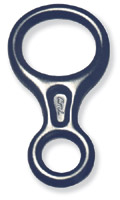
Figure 1, a perfect round 8 word loop 
Figure 2, Huit 
Figure 3, Huit Antibrulure 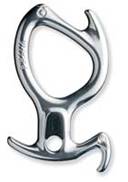
Figure 4, Pirana 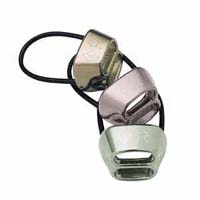
Figure 5, ATC 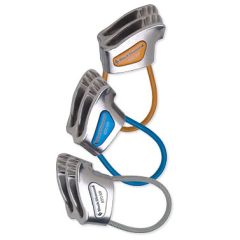
Figure 6, ATC XP 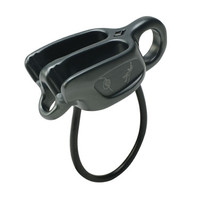
Figure 7, ATC guide 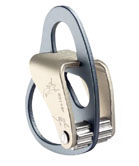
Figure 8, REVERSO 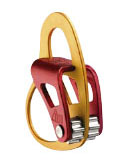
Figure 9, REVERSINO 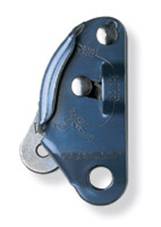
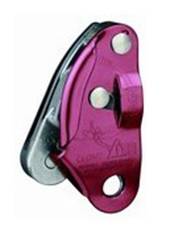
Figure 10, GRIGRI 
Figure 11, STOP 
Figure 12, SIMPLE 


Figure 13, RACK 
Figure 14, ASCENSION 
Figure 15, CROLL 
Figure 16, PANTIN 
Figure 17, TIBLOC 
Figure 18, MICROCENDER 
Figure 19, SHUNT
Take you to know the classification and characteristics of rock climbing equipment - protectors [Photos]
